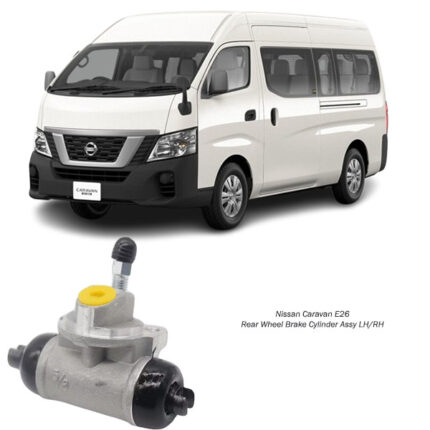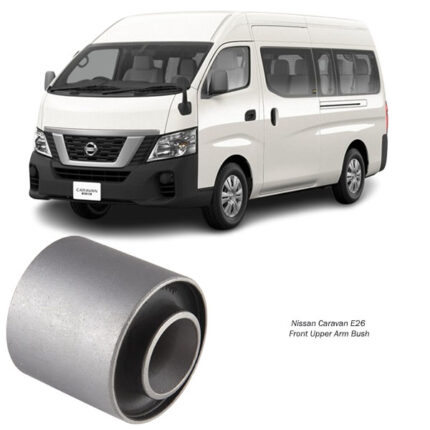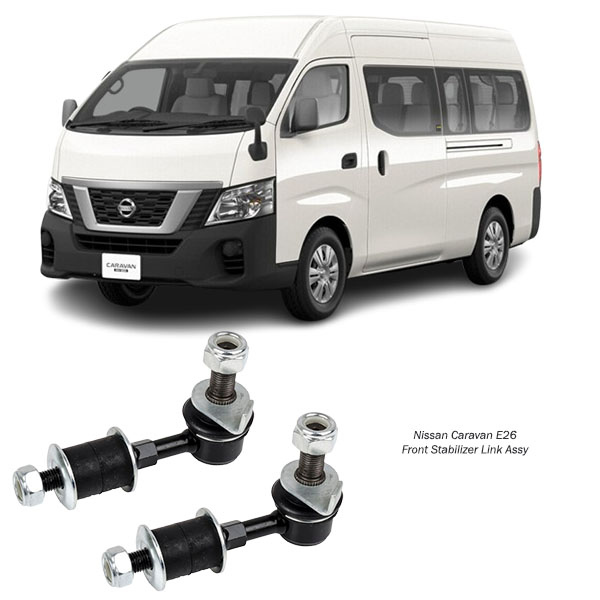-13%
Get Nissan Caravan E26 Front Stabilizer Link Assy 54617-VW000 in Kenya
In the world of suspension components, few parts punch above their weight like the Front Stabilizer Link Assembly. Though it may look small and simple, this component plays a major role in delivering a smooth, stable ride—especially when cornering or navigating uneven roads. When it’s working correctly, you barely notice it. But when it fails, your vehicle’s handling and safety can quickly be compromised.
Let’s take a deep dive into what the front stabilizer link does, how it works, signs of wear, and why it’s a critical part of a properly functioning suspension system.
🔍 What is the Front Stabilizer Link Assembly?
The Front Stabilizer Link Assembly, also known as a sway bar link, is a short rod or bar that connects the stabilizer bar (anti-roll bar) to the suspension strut or control arm on each side of the front suspension.
Each vehicle typically has two stabilizer links at the front—one for the left (LH) and one for the right (RH). These links serve as the bridge between the stabilizer bar and the suspension components.
The typical assembly includes:
-
Ball joints or bushings at each end for flexibility
-
A metal or composite shaft for strength and stability
-
Sometimes rubber boots or sleeves to protect the joints
-
Mounting hardware (nuts and washers) for installation
Despite their size, stabilizer links handle constant movement and stress, helping to keep the vehicle level and controlled under dynamic driving conditions.
⚙️ How It Works
To understand how stabilizer links work, you need to understand the stabilizer bar (also called the sway bar or anti-roll bar). This bar runs across the front (and often rear) of the vehicle and is connected to both sides of the suspension via the stabilizer link assemblies.
Here’s how the system operates:
-
As your vehicle turns, the body naturally wants to roll outward due to centrifugal force.
-
The stabilizer bar resists this rolling motion by transferring some of the load from one side of the suspension to the other.
-
The stabilizer links allow this force transfer by flexing and pivoting with the suspension as it moves up and down.
-
The result is reduced body roll, improved handling, and better tire contact with the road.
Without the stabilizer links, the sway bar wouldn’t be able to communicate with the suspension, making it ineffective.
🧩 Importance of Front Stabilizer Links
Stabilizer links are essential for:
-
🔁 Reducing body roll during turns or lane changes
-
🛞 Improving traction by maintaining consistent tire-to-road contact
-
🚗 Enhancing steering stability
-
🧘 Increasing ride comfort
-
⚖️ Maintaining suspension balance between left and right sides
While they don’t directly affect ride height or load-bearing, they significantly influence the way a vehicle feels and behaves on the road.
🛑 Signs of a Failing Stabilizer Link
Over time, stabilizer links can wear out due to age, road conditions, or exposure to water, salt, and debris. Here are the most common symptoms of a worn or damaged stabilizer link:
1. 🔊 Clunking or Rattling Noises
A loose or broken link will make noise when driving over bumps, potholes, or uneven surfaces. The sound is usually a metallic clunk from the suspension area.
2. 🌀 Poor Handling or Excessive Body Roll
If your vehicle sways more than usual during turns or feels unstable, the stabilizer links might not be transferring forces properly.
3. 🧭 Loose or Sloppy Steering
Damaged stabilizer links can make the steering feel imprecise or “floaty,” especially when cornering.
4. 🔍 Visible Wear or Damage
Upon inspection, look for cracked rubber boots, rusted joints, or broken ends. If the link can be moved by hand, it’s likely worn out.
🔧 Replacement Time – When Should You Change It?
Stabilizer links typically last between 80,000 and 150,000 kilometers, depending on driving conditions and quality of parts. However, replacement may be needed sooner if:
-
The bushings or joints have failed
-
There is visible damage or rust
-
Clunking noises are persistent
-
Handling has noticeably worsened
It’s often a good idea to replace both LH and RH stabilizer links at the same time to maintain consistent performance.
🧰 How Are They Replaced?
Replacing front stabilizer link assemblies is relatively straightforward but requires proper tools and safety procedures. Here’s a general overview:
-
Lift and secure the front of the vehicle on jack stands.
-
Remove the front wheels to access the stabilizer links.
-
Unbolt the old link from the stabilizer bar and suspension.
-
Remove the link and inspect mounting points.
-
Install the new link, aligning it with both ends.
-
Torque bolts to specification to prevent future issues.
-
Reassemble wheels and lower the vehicle.
-
Test drive to ensure improved handling and silence.
Most replacement parts are direct-fit and require no modification. However, always double-check compatibility with your suspension setup.
🛡️ Maintenance Tips for Long Life
Stabilizer links are generally maintenance-free, especially modern versions with sealed ball joints. But you can extend their lifespan with these tips:
✅ Inspect During Routine Service
Whenever you’re servicing brakes, tires, or suspension components, take a look at the stabilizer links. Early detection of wear can prevent bigger problems later.
✅ Avoid Aggressive Driving
Frequent hard turns, fast cornering, or off-roading can accelerate wear on suspension parts—including stabilizer links.
✅ Replace in Pairs
Always replace both links at the same time to keep handling balanced and predictable.
✅ Choose High-Quality Parts
Aftermarket parts with metal ball joints, rust-resistant coatings, and heavy-duty bushings tend to last longer.
🧠 Why It Matters
It’s easy to underestimate such a small part, but the Front Stabilizer Link Assembly plays a major role in ride quality and vehicle safety. When it’s in good condition, you get:
-
Tighter, more responsive steering
-
Greater control in corners
-
A smoother, quieter ride
-
Even tire wear and better suspension alignment
When it fails, it compromises not just comfort but also safety—especially during emergency maneuvers or on slippery roads.
📊 Quick Facts at a Glance
| Feature | Details |
|---|---|
| 🔩 Function | Connects stabilizer bar to suspension |
| 🧰 Common Materials | Steel, composite, rubber bushings, ball joints |
| ⚠️ Signs of Failure | Clunking noises, body roll, loose steering |
| 🔁 Replacement Frequency | 80,000 – 150,000 km (or as needed) |
| 🛡️ Maintenance | Inspect regularly, replace in pairs |
🏁 Final Thoughts
The Front Stabilizer Link Assy is a small but powerful component that plays a vital role in your suspension system’s performance. It’s responsible for keeping your vehicle stable, reducing body roll, and enhancing the overall driving experience—especially when cornering or driving on rough roads.
Though it may not demand daily attention, staying ahead of wear and replacing these links when needed ensures a safer, smoother, and more enjoyable ride. Keep an ear out for those clunks, keep your handling sharp, and always keep the balance—courtesy of your stabilizer links.
Follow us on Facebook for more parts.




Reviews
Clear filtersThere are no reviews yet.